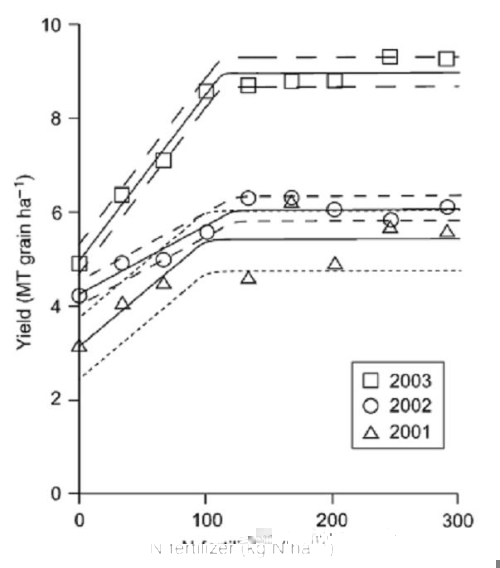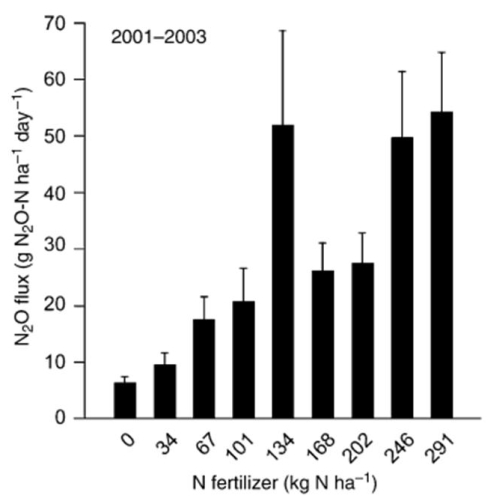

Figure Set 3: Nitrogen Fertilizers Increase Nitrous Oxide Emissions
Cognitive Skills: (see Bloom's Taxonomy) - knowledge, interpretation, synthesis
FIGURE SET
| Carbon Dioxide (CO2) | N2O | |
Atmospheric concentration |
(ppm)* | (ppm) |
| Pre-industrial | 280 | 0.29 |
| Present (2005) | 379 | 0.32 |
| % Increase | 36% | 10% |
Atmospheric lifetime (years) |
50-200 | 114 |
Relative radiative effectiveness |
||
| Per unit mass over 100 years | 1 | 298 |
* ppm: parts per million | ||
Table 3a. This table was constructed using data from the Intergovernmental Panel on Climate Change (IPCC) report in 2007. Information is shown regarding two important greenhouse gases, Carbon Dioxide (CO2) and Nitrous Oxide (N2O). Atmospheric concentration data are reported as parts per million (ppm) in the atmosphere, while the % increase indicates the change in ppm for each gas between pre-industrial and present time points. Table created using data from the Intergovernmental Panel on Climate Change Fourth Assessment Report (2007).

Figure 3a. Corn yields were measured in six replicate fields across a gradient of nitrogen fertilize rates at the W.K. Kellogg Biological Station in SW Michigan from 2001 - 2003. Solid lines indicate modeled grain yields while dashed lines indicate standard error. The term "kg N ha-1" in the x-axis label indicates kilograms of nitrogen fertilizer applied per hectare (one hectare is approximately 2.2 acres). The term "MT grain ha-1" in the y-axis label indicates metric tons of grain produced per hectare (one metric ton is 1,000 kilograms). This figure was taken directly from Figure 2 in McSwiney and Robertson (2005), which is published in the journal 'Global Change Biology.'

Figure 3b. Nitrous oxide (N2O) emissions from soil were measured in six replicate corn fields across a gradient of nitrogen fertilizer rates at the W.K. Kellogg Biological Station in SW Michigan from 2001 - 2003. Nitrous oxide was measured by placing closed chambers over the soil and monitoring the rate of change in N2O in the chambers over time as it was released from the soil. Error bars represent standard error.This figure was taken directly from Figure 1 in McSwiney and Robertson (2005), which is published in the journal 'Global Change Biology.'